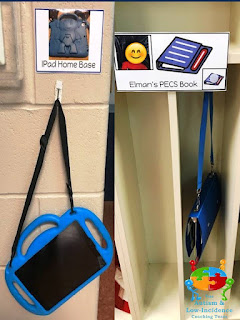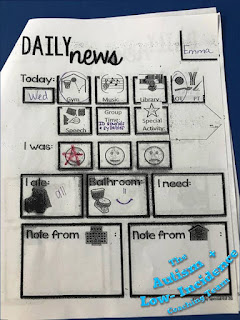Voice regulation can be challenging for many of our students. A volume that does not match the social situation and expectation can impact the way others think about that student and can interfere with communication or learning. Simply telling a student to use a quiet voice may not be enough. Today's Sensational Social Skills post will provide 5 steps to help your student regulate volume.
1. Build Awareness
First, engage the student in activities that build awareness of different voice volumes. Model different volumes and talk about situations when certain voice volumes should be used. Introduce a visual voice volume tool to provide a visual representation of different voice volumes. At this step, you are teaching the student how different levels on the voice volume tool look, sound, and feel.
 |
| Jackie Vollmer Driscoll Elementary, Centerville |
It helps to have an interactive scale that shows the changes by moving a marker. This voice meter uses a moveable star to illustrate the changes in volume.
 |
| Marissa Steinhelfer Harry Russell Elementary, West Carrollton |
Consider incorporating a special interest theme to increase the student's interest in the voice meter. In this interactive cat voice meter, the ball of yarn is moved up and down to show the voice volume.
 |
| Sarah Vikan Harry Russell Elementary, West Carrollton |
This video shows you how to make a voice volume wheel:
Your student may benefit from a social story or narrative to help them understand why it is important to use a volume that is just right for the situation. Teachers Pay Teachers has a variety of pre-made Voice Volume Social Stories available.
Decibella is a great book to teach your younger students about voice volume:
2. Practice Control
Next, provide opportunities for the student to practice controlling their volume during structured activities. This video from How to ABA illustrates how you might practice volume control during structured activities:
In addition to an interactive voice volume tool, consider the use of an app that provides instant feedback to let the student pair what they hear with what they see. Check out this app:
 |
| Dragon Fly Apps: Voice Meter Pro |
3. Prime Volume Expectation
Once the student has demonstrated the ability to control the volume of their voice during structured practice activities, you can begin to help them apply this skill in situations across the day. Prime the use of a target volume prior to the situation. The visual used to prime the expected volume should be similar to the visual used during structured practice. The student needs to know what the target volume sounds like, looks like (on the visual), and how it feels.
The student can be presented with an individual priming tool or you can prime the whole class. Here are examples of a whole class tool to prime for the expected voice volume.
 |
| Mary Schuler Fairborn Intermediate, Fairborn |
 |
| Kelsey Keen Tri-Village Elementary, Tri-Village |
4. Prompt Volume Expectation
After the student has been primed to use the target voice volume and they enter the situation, use a nonverbal prompt if the student starts to move away from the target volume. This can be a reference to the voice volume tool, a “quiet voice” image, or a hand gesture to show the expected voice level.
 |
| Jamie Minnish Prass Elementary, Kettering |
These voice volume scales pair numbers and hand signals with voice levels to provide an easy way to prompt the student to find the right volume in the moment.
 |
| Taylor Ruef Stevenson Elementary, Mad River |
5. Reinforce Target Volume
It will be important to give the student feedback to let them know when they are on target. Consider a nonverbal reinforcement such as referring to the visual tool, giving a thumbs up, or providing a written note. If your student needs more tangible reinforcement, a sticker or edible can be provided when the student stays in the target range for a predetermined time frame. One team considered adding a picture of a special interest item (Sally from the Nightmare Before Christmas) to the interactive voice meter to indicate when the student’s voice was in the expected voice range she could have Sally.
 |
| Sarah Vikan Harry Russell Elementary, West Carrollton |
Keep in mind that if a student is dysregulated, the student may not be able to control their volume. In this case, the best priming, prompting and reinforcement may not help. Determine if the student needs a calming break or if there is an issue that needs to be addressed to help the student feel more regulated and in control.















































